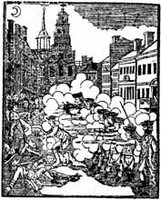John Green’s View of the Massacre
 On 24 Mar 1770, five days after a draft of Boston’s report on the Massacre was submitted to the town meeting, justices of the peace John Ruddock and John Hill quizzed John Green about what he’d seen on the night of the 5th.
On 24 Mar 1770, five days after a draft of Boston’s report on the Massacre was submitted to the town meeting, justices of the peace John Ruddock and John Hill quizzed John Green about what he’d seen on the night of the 5th.
I spent some time earlier this week trying to figure out who John Green was, and this is my best guess. He was descended from a line of three Bartholomew Greens. His great-grandfather and grandfather were both newspaper printers, and his uncle John (1731-87) was still in that business as co-publisher of the Boston Post-Boy until 1773. But, as Isaiah Thomas described, John Green’s father had carved out his own niche:
Bartholomew, the eldest [son]…, never had a press of his own. The following peculiarity in his character introduced him to a particular intercourse with the merchants of the town; he made himself so well acquainted with every vessel which sailed out of the port of Boston, as to know each at sight. Perpetually on the watch, as soon as a vessel could be discovered with a spyglass in the harbor, he knew it, and gave immediate information to the owner; and, by the small fees for this kind of information, he principally maintained himself for several years. Afterwards he had some office in the custom house.John’s ship-spotting father Bartholomew looked after the Customs office on King Street, with his unmarried daughter Ann helping out. The printer John Green also had ties to the Customs service; its officials granted him printing contracts, and his newspaper tended to support the royal government.
The younger John and his brother Hammond, who had been given their grandmother’s maiden name and was legally a “boat-builder,” both went to the Customs office on the evening of 5 Mar 1770, probably to make sure their relatives were all right. This is how John later described his experience to the magistrates in a deposition:
I, John Green, of lawful age, testify and say, that on Monday evening the 5th instant [i.e., of this month], just after nine o’clock, I went into the Custom-house, and saw in the kitchen of said house two boys [Edward Garrick and Bartholomew Broaders] belonging to Mr. [John] Piemont the barber, and also my brother Hammond Green;When John Green testified, Boston officials suspected that Customs service employees had killed people in the crowd by firing guns from an upper window of the building. Green’s brother Hammond and Thomas Greenwood were indicted for murder—despite Green putting Greenwood at the guard-house when the shooting started.
upon hearing an huzzaing and the bell ring, I went out, and there were but four or five boys in King street near the sentinel [Pvt. Hugh White], who was muttering and growling, and seemed very mad. I saw Edward Garrick who was crying, and told his fellow-apprentice that the sentinel had struck him.
I then went as far as the Brazen-Head [importer William Jackson’s shop sign], and heard the people huzzaing by Murray’s barrack [rented to the army by James Murray on behalf of his sister Elizabeth Smith], I went down King-street again, as far as the corner of Royal Exchange lane, by the sentry, there being about forty or fifty people, chiefly boys, near the Custom-house, but saw no person insult, or say anything to the sentry; I then said to Bartholomew Broaders, these words, viz.: the sentry (then standing on the steps and loading his gun), is going to fire;
upon which I went to the Custom-house gate and tried to get over the gate, but could not; whilst standing there, I saw [Customs tide waiter] Thomas Greenwood upon the fence, to whom I said, open the gate; he said that he would not let his [own] father in, and then jumped down into the lane and said to the deponent, follow me; upon which I went down the lane with him, and round by the Post-office, to the main-guard;
he went into the guard-house and said, turn out the guard, but the guard was out before, and I heard that a party was gone to the Custom-house; I then heard the guns go off, one after another, and saw three persons fall;
immediately after, a negro drummer [of the 29th regiment] beat to arms, upon that the soldiers drew up in a rank (and I did not see Greenwood again, until the next morning), after that I saw the 29th regiment drawn up in a square, at the south-west corner of the Town-house; soon after I went home; and further I say not
At the end of the year those two men stood trial alongside Customs official Edward Manwaring and notary John Munro, all accused on the basis of dubious testimony from a teen-aged servant named Charles Bourgate. They were quickly acquitted.
The statements of John Green, his relatives, and Thomas Greenwood fit well together and also match testimony from other witnesses, unrelated and unindicted. Those accounts helped to inform the script of tonight’s reenactment of the Boston Massacre outside the Old State House.

No comments:
Post a Comment